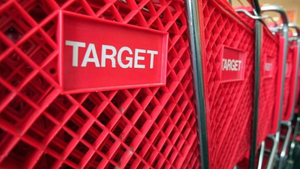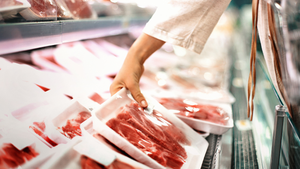NATURAL SELECTION 1996
Ginseng, echinacea, garlic, saw palmetto and other herbal products are cultivating nutritional supplement sales at supermarkets, retailers report."Herbals are the hottest segment in food supplements, which have doubled in sales for us every year, and it's getting hotter," said Steve Smith, nonfood buyer at Woodman's Food Markets, Janesville, Wis.Herb sales have grown by about 10% to 20% at some chains
April 22, 1996
JOEL ELSON
Ginseng, echinacea, garlic, saw palmetto and other herbal products are cultivating nutritional supplement sales at supermarkets, retailers report.
"Herbals are the hottest segment in food supplements, which have doubled in sales for us every year, and it's getting hotter," said Steve Smith, nonfood buyer at Woodman's Food Markets, Janesville, Wis.
Herb sales have grown by about 10% to 20% at some chains over the last year, and are expected to grow even higher due to the baby boomer generation and overall increased interest in healthier living. Some retailers report that herbals are more profitable than regular vitamins.
Food store sales of nutritional supplements for the year ended Dec. 9, 1995, were $126.6 million, a 22% increase over the year before, according to A.C. Nielsen, Chicago. Nielsen doesn't track sales of herbals exclusively, but several herbal brands showed significant growth over a year ago.
Two ginseng brands, Kyolic and Garlique, posted dollar volume gains 56% and 79%, respectively, and Ginsana sales rose 16% during the 12-month period. Such increases are getting retailers attention as they begin to give herbals more shelf space, increased product variety and greater exposure in ads.
Herbals are widely used as an alternative to drugs and medicines. They've been touted as a natural way to increase energy, prevent colds, boost immunity and improve sleep. Ginseng, for instance, is said to help maintain physical endurance, echinacea is held to improve the immune system and saw palmetto reportedly keeps the prostate healthy.
Others include bilberry and milk thistle, for eye and liver health, respectively, and dong quai and ginger, for menstrual pain and nausea relief, respectively.
Buyers contacted agreed that the rising demand for herbals is closely tied to the "baby boomer syndrome."
"The baby boomer generation tends to use more natural preventative types of medicine, and is more willing to experiment with natural health remedies," said a director of nonfood at a Southwest chain, who did not want to be identified.
Younger consumers are equally interested in maintaining their health, said Dan Dailey, senior health and beauty care buyer at Carr Gottstein Foods, Anchorage, Alaska.
"Herbals are really taking off," said Anne Edey, natural and specialty foods buyer at Raley's Supermarkets, West Sacramento, Calif. She said herb sales increased 15% to 20% over the last year.
Raley's carries more than 100 herbal items in a 4-foot endcap in its 1,000-square-foot natural health department.
Raley's also has introduced six herbals, including ginseng, to its vitamin section in HBC. Merchandising herbals at HBC, near pharmacy, will test a dual placement for the segment, said John Raley, HBC buyer-merchandiser for the drug division.
"Placing a limited assortment of herbals into the vitamin category in HBC is an experiment with a multiple display location," Raley said. "It will also let us see how well they do near pharmacy." The mix will be promoted in vitamin ads within the next few months.
Randalls Food Markets, Houston, has carried herbals for about a year. It merchandises the segment in a 4-foot endcap near vitamins in HBC. The segment is promoted with vitamin ads on a monthly basis.
"Herbals are a good growth area" said Gary Crawford, category manager for HBC.
At Randalls, herbal profits are comparable to vitamins, but other chains report that they're doing even better. At Woodman's, for instance, herbal profits are 5% to 10% higher than vitamins.
Herbals are also more profitable than vitamins at the Southwest chain, with margins at 35% to 40%, compared with 31% to 32% for vitamins. At the Southwest chain, sales are up about 22% over the year before.
This spring the Southwest chain added 30 to 40 new stockkeeping units, which were integrated with the regular vitamin mix. It obtained space in the vitamin section by dropping items that had declining sales. It previously tested herbals with in-and-out floor stands.
These kinds of numbers are leading retailers to re-evaluate their vitamin displays. Fairway Foods, Minneapolis, and Raley's have carved out space for the mix by removing slow-moving product.
Woodman's, meanwhile, merchandises the assortment in 20 feet of in-line space near vitamins.
Carr Gottstein began merchandising herbals from 1,000-square-foot alcoves in its natural food section. These sections offer a mix of soy-based products and natural and organic items similar to a health food store, said Dailey.
Genuardi's Family Markets, Norristown, Pa., currently doesn't sell herbals, but plans to in the near future, said Mike Kilgallon, category manager for HBC. It has had presentations, and is interested, and is now in discussions with its suppliers -- Fleming Cos.' Oaks, Pa., division, and Super Rite Corp., Harrisburg, Pa.
When it does get them in, it will integrate them in its HBC mix, rather than create a separate section, Kilgallon said.
The most difficult aspect of an herbal program is deciding which varieties to carry. Some of the faster-moving varieties include ginseng, saw palmetto, chamomile, echinacea, garlic and ginger. But many others also are emerging.
Retailers are using various sources to stay on top of the latest trends in this segment.
Smith of Woodman's said he attends trade shows, eyes health food stores and picks up news on products from food brokers.
Woodman's relies on customer preferences to determine which items to carry since it has enough display space for a wide-ranging assortment in its 200,000-square-foot stores, Smith said.
While retailers are becoming more educated, the majority of consumers remain uninformed about the segment, retailers told SN.
"Only about 10% of consumers are knowledgeable about herbals," said Dailey of Carr Gottstein.
"There needs to be a lot more education on these products," agreed Terry Born, category manager of vitamins at Fairway Foods.
But retailers anticipate that there will be heightened exposure in the near future. Already, suppliers are reacting quickly to new entries, retailers told SN.
About the Author
You May Also Like




